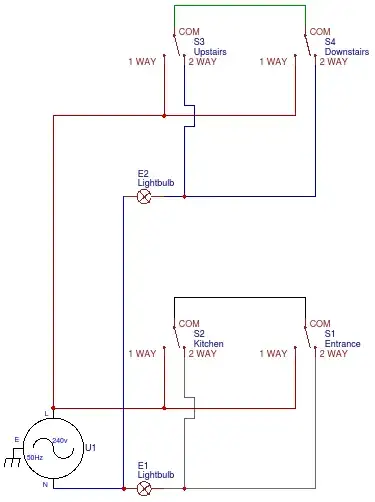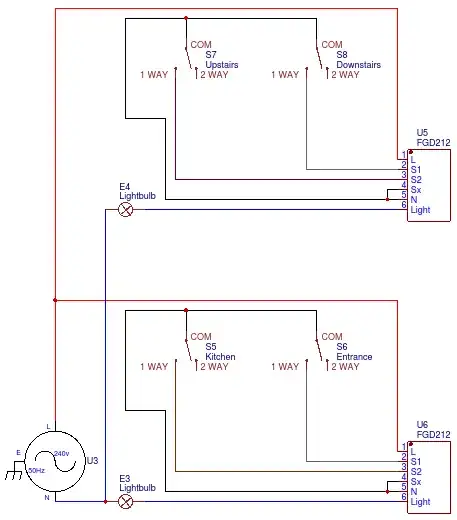I'm looking for a set of Z-Wave (preferably Z-Wave Plus) components to use in order to merge two 2-way light switch circuits and allow control of both lights from all switch positions. I've looked at Fibaro FGD-212 modules but I don't think they'll meet my needs.
I'll give as much detail below as I can about my current setup and what I've investigated.
This is for UK home wiring, in case that matters.
My lounge and stairs leading from it have one ceiling light each and both have two switches (making 4 distinct switches in total, no correlation in placement).
I've also been investing (slowly) in Z-Wave equipment, and have started to design a replacement for the switches which would allow:
- Both the stairs switches to have 2 physical switches each, one controlling the upstairs hallway and another controlling the lounge
- One of the lounge switches to have 2 physical switches, with the controls the same as above
- The other lounge switch to have a single physical switch which only controls the lounge light (not a problem if they are all double, though)
My initial hope was to use 3 * double switches and a single switch, wire them up and control it all with code, but that was before I learnt how 2-way circuits work.
Current setup
3-core (plus ground) 2-way light switch circuits for both the stairs/hallway and lounge:
Explored approach
I stumbled upon a guide to using Fibaro Dimmer 2 modules to achieve this, which would change the circuit to the following:
I can see how the wiring and module would work, but my issues with using the module are:
- The modules (FGD-212) seem large to be wired behind the existing switch (20.3mm thick)
- They only use a single, standard light switch, so doesn't solve my initial problem as far as I can tell
- Can't use z-wave switches on top of the hidden modules. I'd rather use smart switches rather than hidden modules (for indicator lights, multi-function buttons, etc)
- To use it with my CFL lights I'll need to buy another device with it, a Bypass 2 (FGB-002), which will increase the amount of stuff I have to fit behind my switch, or inside my light fixture.
- It only advertises to control dimmable lights, not switching
- Their 'switch' equivalent modules are not capable of 2-way circuits
I've considered changing the circuits so that only one of the switches in each physically control the light, but that isn't an option as I'd like to plan for a failure scenario which would leave one of the switches on each circuit useless.
Is there a combination of z-wave switches which will enable 2-way switches? It must be a common problem.

